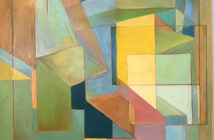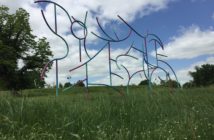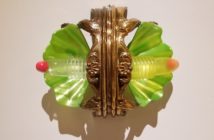“With my work I reaffirm black cultural values in the contemporary world.” – Juan Roberto Diago Durruthy, 1998
Curated by Alejandro de la Fuente, Diago: The Past of This Afro-Cuban Present at The Cooper Gallery presents Juan Roberto Diago Durruthy’s first retrospective. Diago’s work is expository; a knowledge producer, Diago reconstructs a new history of the Afro-Cuban cultural movement. In so doing, Diago’s work exposes the history of oppression from the perspective of both oppressed and oppressor, forcing acknowledgment and revision of subjugation.
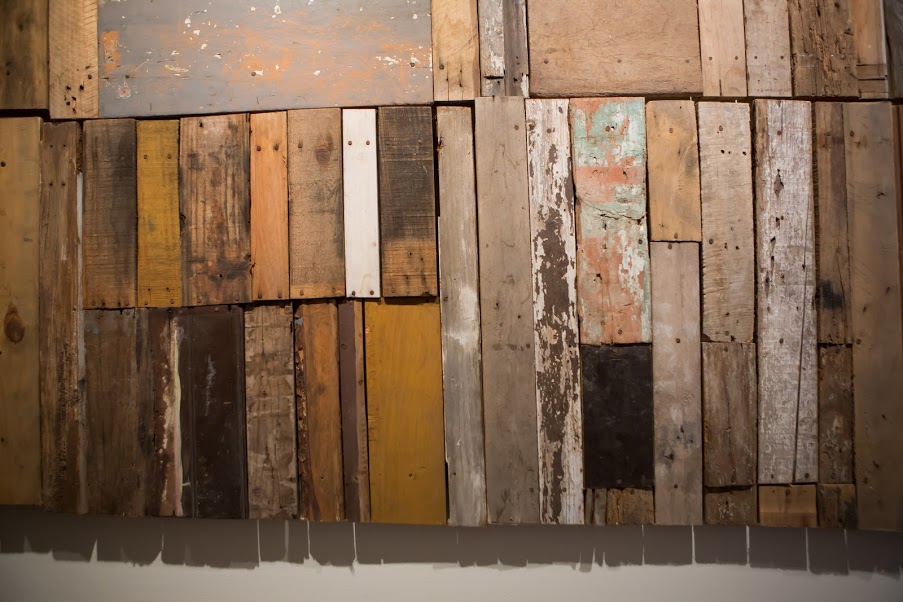
De la Serie El Rostro de la Verdad (From the Series: The Face of Truth), 2013. Variable Size. Installation, wood. Courtesy of the Artist and Magnan Metz Gallery, New York.
The vast exhibition encompassing 25 mixed-media and installation works, guides the viewer through a history of race and racism, trauma, and street culture in Cuba. Using the visual language of graffiti and street sayings, Diago uses burlap tableaus to weave the history of racial inequality and traumas of a colonized Cuba. Here, artist Chanel Thervil and I discuss Diago’s work in connection to race and history in relationship to resilience and healing. –Silvi Naci
Chanel Thervil: Diago’s work is like a hybrid of Jean-Michel Basquiat and Jasper Johns. There is a throughline of tension between the internal and external struggles of trying to navigate through race, history, and the lens through which both are remembered. Diago approximates the pain experienced as a result of this tension (oppression, discrimination) by manipulating the “skin” of his materials and found objects with cuts, scrapes, stitches, and burns. Walking through the exhibition forces the viewer to take this uncomfortable journey with him, while simultaneously questioning what does it take to actually cause these wounds to heal for good?

“Mi Historia es Tu Historia [My History is Your History]” (2000), mixed media on canvas. Courtesy of the Cooper Gallery.
: In a conversation with curator Alejandro de la Fuente, I heard Diago speak about the importance of looking at the past in order to understand the present. As you enter the gallery, you are met with “Autorretrato, 2000” Diago’s self-portrait. This is where I see the trauma beginning, with each keloid, scar, and memory guiding you into the pits of Diago’s story, and his sense of belonging as a black man. Walking through the hallway into the gallery, the walls are covered with found construction materials with original marks from previous lives, stacked like books in a library with histories of enslavement and hope.

“Huella en la Memoria [Memory Footprint]” (2015), metal. Courtesy of The Cooper Gallery.
: Before you can speak, you are seen. In many societies, skin is an indicator of race that is loaded with connotations and histories that the bearer has no control over, but is always at the mercy of for judgment and classification. On a biological level, skin is our largest organ, covering our entire bodies as a means of protecting all that lies within. It’s stretchy, resilient, and repairs itself when damaged. The pains which marginalized peoples are subjected to parallel the techniques Diago uses for creating his work (cutting, bruising, and burning). The skin’s attempt to heal in spite of this abuse and marginalized peoples attempt to survive in a rigged game, establishes the physical and psychological scars that offer no solutions or remedies for pains of the past, present, and future.

“Aché Pa’ Los Míos [(loosely) Good Vibes for My People]” (1999), mixed media on burlap. Courtesy of The Cooper Gallery.
: The mark making, textures, and materials are very significant to the narrative of Diago’s work. The history of the wood, burlap, and decayed metals used in each piece strengthen the discourse. In the beginning, the selection of material was driven by necessity, which later became a strategy to reinforce the concept of the work. As Diago said. “I have tried to use canvas before instead of burlap, but its connotation and history is different and doesn’t look the same. I have tried preparing open and clear canvas, I have tried to discharge my message on that canvas but it doesn’t convey the same message. It’s like a recipe, sometimes you have the best ingredients, but the soup never comes out like grandmas.”
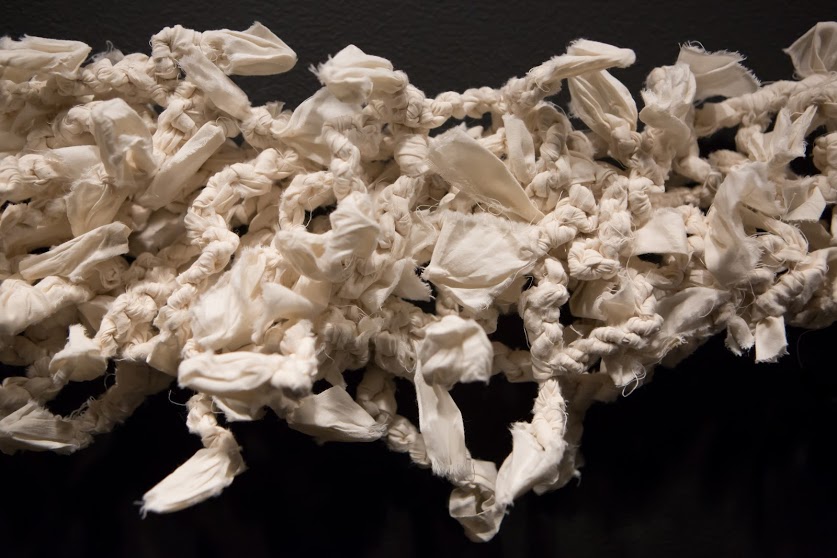
Queloide (Keloid), 2013. Cloth on wall. Variable size (335”). Courtesy of the Artist and Magnan Metz Gallery, New York.
CT: The piece "Queloide" (Keloid, 2013) is a pathway between the galleries and bodies of work. Compared to the other pieces you are looking at just before it, it’s very muted and graphic via the contrast of the black wall and the central island of white fabric that's been knotted to form a keloid. There were three main thoughts swimming in my head as I encountered this piece: The first was race relations: These issues are discussed as though they are just black and white, but there are so many complexities ignored, continuing to build up onto each other in a way that leaves you unable to find a beginning or an end. Second, Is whiteness--and all that comes with it--a keloid on blackness that keeps marginalized people from fully healing, being healthy, and living in a way that allows them to reach their fullest potential?
And lastly, If keloids are formed on the skin you already have, what is Diago communicating with a white keloid? Is aspiring to reach the standards forced onto blackness by whiteness foreign, or is whiteness just trying to mutate away from its true roots, blackness? “My attitude may seem aggressive because my work is like a manifesto against racism. More than in a man’s social status or skin color, I am interested in the integration of human beings,” says Diago.
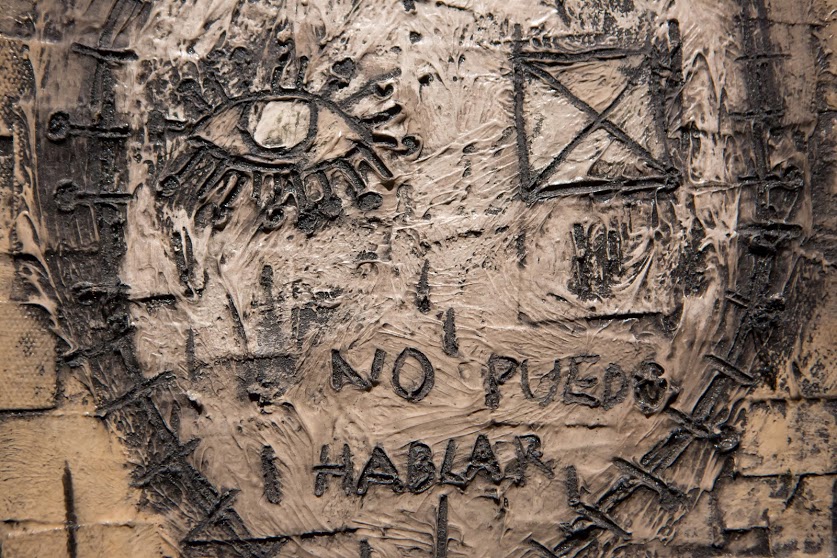
No Puedo Hablar (I Can’t Speak), 2000. Mixed media on canvas. 31 5/8” x 23”.Courtesy of Cernuda Art.
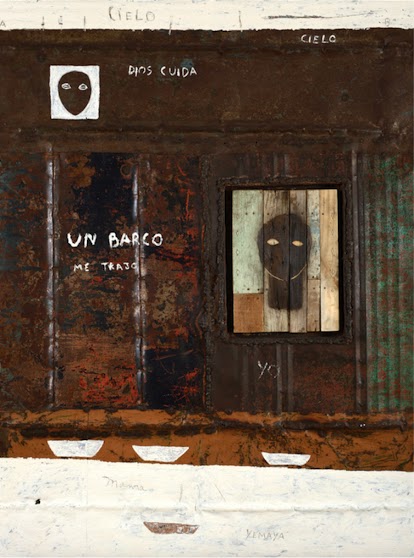
“Un Pedrazo de Mi Historia [A Piece of My History]” (2003), mixed media on metal. Courtesy of The Cooper Gallery.
: In Diago’s work, the history of Cuba is filled with the blood and misery of displaced Africans, reminiscent of
Radcliffe Bailey and his works on paper, such as Notes from Tervuren created on classical music sheets played during the time of slavery, with references to African art as it connects to identity and understanding the past. Similarly, during a crucial moment in US history as we grapple with our political systems, Diago confronts us with the bitter truth of the migrant, an alien, the traveler que se trajo un barco hoping dios la cuida, leaving reminders on each painting for a future life.* In “Un Pedazo de mi Historia, 2003” (A piece of My History), a painted head on found metal brings to mind Diago’s grandmother as we see her presented in Josefina Urfe University of Havana registration card as well as temporary immigration papers for refugees crossing the waters for a better life.
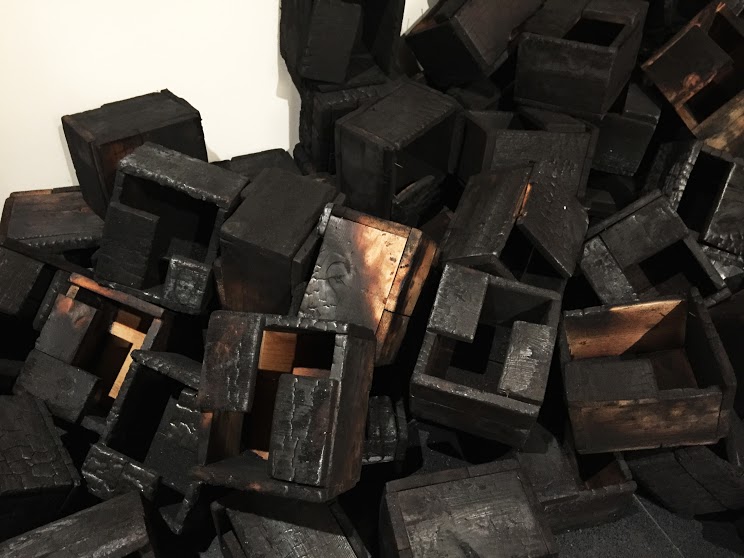
"Ciudad en Ascenso [Ascending City]” (2010), installation, wood . Courtesy of The Cooper Gallery.
: Diago’s “Ascending City, 2010” is the hidden trophy of the exhibition, rewarding visitors after experiencing visceral two-dimensional works. Despite being installed in the corner of the final gallery, the presence of this installation is impossible to ignore. Immediately your eyes are engulfed in a massive mountain of wooden cubes. Most of them are burned and charred, but there are a few surfaces left unaffected. The placement of the wooden cubes, both the pile up in the corner and the individual pieces that hang in isolation on the walls and ceilings, look like they are trying to expand upon the paths of possibility for the next wave. Overall, this work evokes the feeling of being in transit, despite the physical barrier of being stagnant. This directly relates to the plight of marginalized people surviving, thriving, and making attempts to move forward in spite of the challenges whiteness and its oppression presents to them. WE ARE HERE. We live. And in many ways, that in itself is a form of resilience and resistance.

"Sin Titulo [Untitled]” (2011), mixed media on canvas. Courtesy of The Cooper Gallery.
: It’s so important that there’s a space like The Cooper Gallery which gives an opportunity to artists of color to have important conversations on race, displacement, and migration for a new vision. Diago is not alone in the exploration of new systems of justice; preceding his show,
Carrie Mae Weems presented a powerful exhibition on gender, race, and class. The Harvard Art Museums presenting work on trauma and memory in a solo show of
Doris Salcedo’s work. Collectively these three shows remind us that there’s still a lot of social justice work to be done in contemporary art practices and the art market. The systems Diago presents are not only about understanding the past but also a fundamental movement in rewriting the history of Cuba and focusing on the future.

De la Serie El Rostro de la Verdad (From the Series: The Face of Truth), 2013. Variable Size. Installation, wood, variable size. Courtesy of the Artist and
Magnan Metz Gallery, New York.
Diago: The Pasts of This Afro-Cuban Present, curated by Alejandro de la Fuente, Director of the Afro-Latin American Research Institute at the Hutchins Center for African & African American Research, is on view at The Cooper Gallery through May 5, 2017.
Notes:
From painting Un Pedazo de Mi Historia [A Piece of My History], 2003
*que se trajo un barco - who brought a boat
*dios la cuida - may god guide you/care for you











